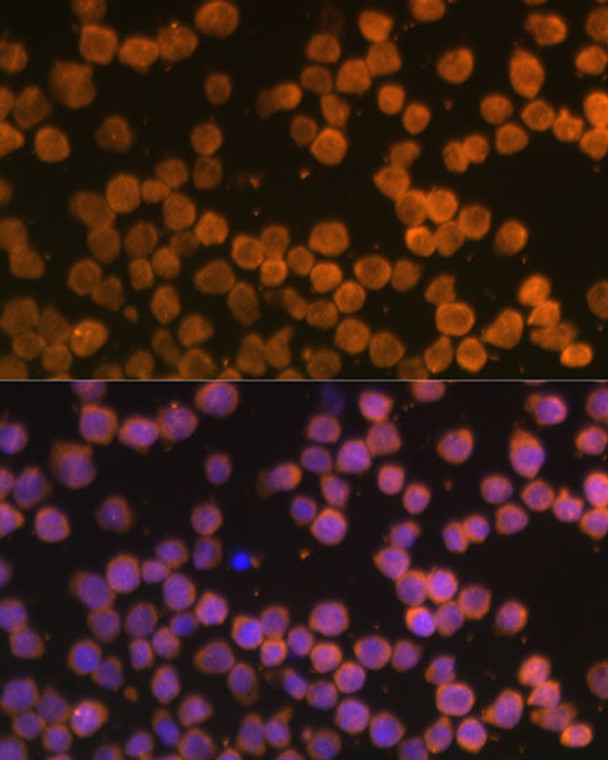| Host: |
Rabbit |
| Applications: |
WB/IF |
| Reactivity: |
Human/Mouse/Rat |
| Note: |
STRICTLY FOR FURTHER SCIENTIFIC RESEARCH USE ONLY (RUO). MUST NOT TO BE USED IN DIAGNOSTIC OR THERAPEUTIC APPLICATIONS. |
| Short Description: |
Rabbit polyclonal antibody anti-TNFRSF10A (269-468) is suitable for use in Western Blot and Immunofluorescence research applications. |
| Clonality: |
Polyclonal |
| Conjugation: |
Unconjugated |
| Isotype: |
IgG |
| Formulation: |
PBS with 0.02% Sodium Azide, 50% Glycerol, pH7.3. |
| Purification: |
Affinity purification |
| Dilution Range: |
WB 1:500-1:2000IF/ICC 1:50-1:100 |
| Storage Instruction: |
Store at-20°C for up to 1 year from the date of receipt, and avoid repeat freeze-thaw cycles. |
| Gene Symbol: |
TNFRSF10A |
| Gene ID: |
8797 |
| Uniprot ID: |
TR10A_HUMAN |
| Immunogen Region: |
269-468 |
| Immunogen: |
Recombinant fusion protein containing a sequence corresponding to amino acids 269-468 of human TNFRSF10A (NP_003835.3). |
| Immunogen Sequence: |
GGDPKCMDRVCFWRLGLLRG PGAEDNAHNEILSNADSLST FVSEQQMESQEPADLTGVTV QSPGEAQCLLGPAEAEGSQR RRLLVPANGADPTETLMLFF DKFANIVPFDSWDQLMRQLD LTKNEIDVVRAGTAGPGDAL YAMLMKWVNKTGRNASIHTL LDALERMEERHAREKIQDLL VDSGKFIYLEDGTGSAVSLE |
| Tissue Specificity | Widely expressed. High levels are found in spleen, peripheral blood leukocytes, small intestine and thymus, but also in K-562 erythroleukemia cells, MCF-7 breast carcinoma cells and activated T-cells. |
| Post Translational Modifications | Palmitoylated. Palmitoylation of TNFRSF10A is required for its association with lipid rafts, oligomerization and function in TRAIL-induced cell death. Palmitoylated by ZDHHC3 (Probable). |
| Function | Receptor for the cytotoxic ligand TNFSF10/TRAIL. The adapter molecule FADD recruits caspase-8 to the activated receptor. The resulting death-inducing signaling complex (DISC) performs caspase-8 proteolytic activation which initiates the subsequent cascade of caspases (aspartate-specific cysteine proteases) mediating apoptosis. Promotes the activation of NF-kappa-B. |
| Protein Name | Tumor Necrosis Factor Receptor Superfamily Member 10aDeath Receptor 4Tnf-Related Apoptosis-Inducing Ligand Receptor 1Trail Receptor 1Trail-R1Cd Antigen Cd261 |
| Database Links | Reactome: R-HSA-140534Reactome: R-HSA-202733Reactome: R-HSA-3371378Reactome: R-HSA-5213460Reactome: R-HSA-5218900Reactome: R-HSA-6803211Reactome: R-HSA-69416Reactome: R-HSA-75158 |
| Cellular Localisation | Cell MembraneSingle-Pass Type I Membrane ProteinMembrane RaftCytoplasmCytosolPalmitoylation Is Required For Association With Membranes |
| Alternative Antibody Names | Anti-Tumor Necrosis Factor Receptor Superfamily Member 10a antibodyAnti-Death Receptor 4 antibodyAnti-Tnf-Related Apoptosis-Inducing Ligand Receptor 1 antibodyAnti-Trail Receptor 1 antibodyAnti-Trail-R1 antibodyAnti-Cd Antigen Cd261 antibodyAnti-TNFRSF10A antibodyAnti-APO2 antibodyAnti-DR4 antibodyAnti-TRAILR1 antibody |
Information sourced from Uniprot.org
12 months for antibodies. 6 months for ELISA Kits. Please see website T&Cs for further guidance









